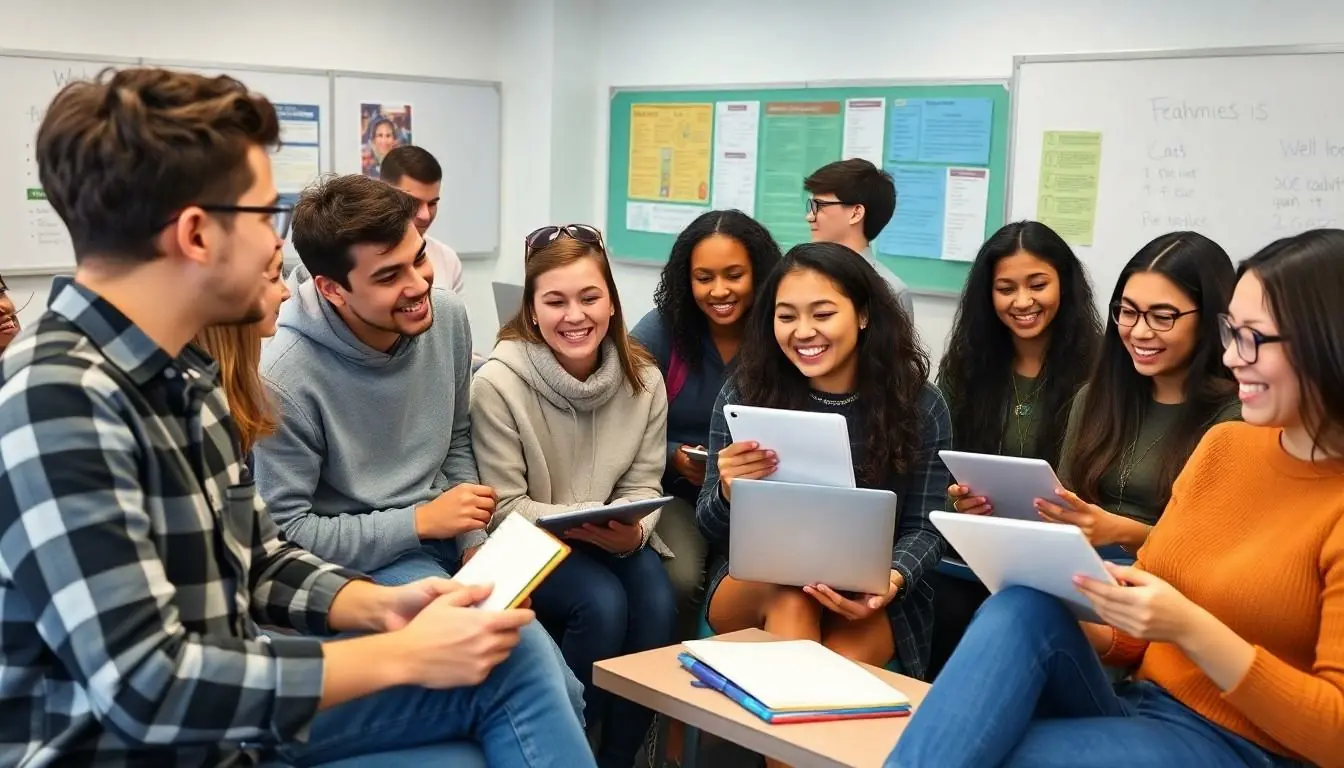In the bustling world of academia, student feedback surveys are the secret sauce for enhancing the learning experience. Imagine a classroom where teachers not only hear the sound of crickets but also the valuable voices of their students. These surveys transform the age-old lecture into a dynamic dialogue, allowing educators to fine-tune their methods and keep students engaged.
Table of Contents
ToggleUnderstanding Student Feedback Surveys
Student feedback surveys play a crucial role in enhancing the educational environment. They gather insights that help educators understand student experiences and perspectives.
Importance of Student Feedback
Student feedback proves essential for improving teaching quality. Survey responses provide data on various aspects of courses, such as content clarity and engagement levels. Active participation shows students their opinions matter. Enhanced communication fosters a sense of community between students and instructors, leading to enriched educational experiences. Regular analysis of survey results helps identify trends and areas for improvement. Using this information, institutions can adapt their curriculum to meet diverse student needs.
Objectives of Conducting Surveys
Conducting surveys aims to collect relevant data from students about their learning experiences. Setting specific objectives streamlines the feedback process and allows educators to target areas for enhancement. Gathering information about teaching effectiveness informs instructors about necessary adjustments. Understanding student satisfaction helps identify strengths and weaknesses in course delivery. Lastly, analyzing feedback supports continuous improvement efforts and drives institutional success.
Types of Student Feedback Surveys
Different types of student feedback surveys serve distinct purposes in enhancing the educational experience. Each type focuses on specific aspects of learning, allowing institutions to gather targeted insights.
Course Evaluation Surveys
Course evaluation surveys gather feedback on course content, structure, and overall effectiveness. Students assess the relevance of materials and the pace of instruction. These surveys help identify areas for improvement, enrich course design, and ensure alignment with learning outcomes. It’s essential to collect feedback periodically to adapt courses to evolving student needs. By analyzing survey results, educators can enhance course delivery and engagement levels.
Instructor Feedback Surveys
Instructor feedback surveys focus specifically on teaching performance and interaction. Students evaluate instructors on their clarity, approachability, and engagement techniques. This feedback fosters communication between students and instructors, promoting a supportive learning environment. Regularly conducting these surveys enables educators to refine their teaching strategies and effectively address challenges. Implementing changes based on survey insights helps improve student satisfaction and learning outcomes.
Designing Effective Student Feedback Surveys
Effective student feedback surveys capture essential insights that direct improvements in teaching and learning. Crafting these surveys involves strategic planning and thoughtful question design.
Key Questions to Include
Key questions guide survey responses and drive meaningful feedback. Incorporate queries about course content clarity, pacing, and engagement levels. Inquire about students’ perceptions of the instructor’s teaching methods and approachability. Evaluate aspects like student satisfaction and recommendations for course enhancements. Utilize open-ended questions to allow students to elaborate on their experiences. These questions foster in-depth responses, enabling educators to understand individual student perspectives better.
Ensuring Anonymity and Honesty
Anonymity plays a crucial role in achieving honest feedback. Providing anonymity reassures students that their responses are confidential, encouraging them to share candid insights. Clearly state survey anonymity policies to foster trust. Implementing anonymous survey tools reinforces this commitment to privacy. When students feel safe to express their views, the quality of feedback improves significantly. Ensuring honest engagement elevates the overall effectiveness of the feedback process.
Analyzing Survey Results
Analyzing survey results plays a crucial role in understanding student experiences. This process involves a careful examination of both quantitative and qualitative data.
Quantitative vs. Qualitative Data
Quantitative data offers numerical insights, making it easier to measure trends and patterns in student feedback. This data provides percentages, averages, and ratings, which help identify areas requiring improvement. Qualitative data complements quantitative insights by offering descriptive responses that explain students’ feelings and experiences in detail. It captures students’ perceptions, giving context to the numbers. A combination of both data types presents a comprehensive view of feedback, guiding educators in enhancing teaching strategies.
Common Metrics Used
Common metrics in student feedback surveys include course content clarity, instructor engagement, and student satisfaction levels. Course clarity ratings often reveal how well concepts are understood. Instructor engagement scores indicate how effectively teachers connect with students. Student satisfaction metrics provide an overall picture of the learning experience. Additional metrics might measure pacing, instructional methods, and relevance to real-world applications. Collectively, these metrics help institutions make data-driven decisions to improve the educational environment.
Implementing Changes Based on Feedback
Implementing changes based on student feedback fosters a responsive educational environment. Educators can enhance teaching approaches by actively integrating insights from surveys.
Strategies for Improvement
Collecting student feedback serves as a valuable resource for identifying areas needing improvement. Educators can use data to adjust teaching methods, course materials, and classroom activities. Prioritizing common themes from survey responses ensures that modifications address the most pressing concerns. Integrating structured feedback into course design helps align educational offerings with student needs. Additionally, seeking further input from students periodically can refine these strategies, making continuous improvement a part of the learning culture.
Communicating Changes to Students
Clear communication about implemented changes encourages student engagement. Informing students of enhancements made due to feedback reinforces their importance in the process. Utilizing emails, announcements, and classroom discussions keeps students updated on modifications. Highlighting specific examples of feedback leading to change strengthens connections between educators and students. Regularly inviting further input fosters an ongoing dialogue, promoting a collaborative learning atmosphere where students feel valued.
Conclusion
Student feedback surveys are essential tools for enhancing the educational experience. They not only promote open communication between students and educators but also foster a collaborative atmosphere that encourages ongoing improvement. By actively engaging with survey results and implementing changes, institutions can create a responsive learning environment that meets evolving student needs.
The thoughtful design of surveys and the analysis of both quantitative and qualitative data provide valuable insights into teaching effectiveness and student satisfaction. When students see their feedback leading to tangible changes, it strengthens their connection to the learning process. Prioritizing regular feedback ensures that educators can adapt and refine their methods, ultimately enriching the overall educational experience for everyone involved.





